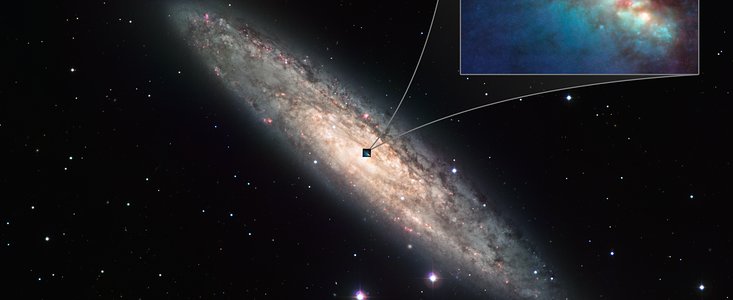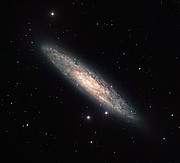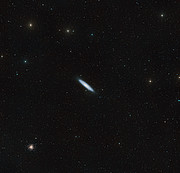Communiqué de presse
Frantic activity revealed in dusty stellar factories
19 janvier 2009
Thanks to the Very Large Telescope's acute and powerful near-infrared eye, astronomers have uncovered a host of new young, massive and dusty stellar nurseries in nearby galaxy NGC 253. The centre of this galaxy appears to harbour a twin of our own Milky Way's supermassive black hole.
Astronƒomers from the Instituto de Astrofísica de Canarias (Spain) used NACO, a sharp-eyed adaptive optics instrument on ESO's Very Large Telescope (VLT), to study the fine detail in NGC 253, one of the brightest and dustiest spiral galaxies in the sky. Adaptive Optics (AO) corrects for the blurring effect introduced by the Earth's atmosphere. This turbulence causes the stars to twinkle in a way that delights poets, but frustrates astronomers, since it smears out the images. With AO in action the telescope can produce images that are as sharp as is theoretically possible, as if the telescope were in space.
NACO revealed features in the galaxy that were only 11 light-years across. "Our observations provide us with so much spatially resolved detail that we can, for the first time, compare them with the finest radio maps for this galaxy — maps that have existed for more than a decade," says Juan Antonio Fernández-Ontiveros, the lead author of the paper reporting the results [1].
Astronomers identified 37 distinct bright regions, a threefold increase on previous results, packed into a tiny region at the core of the galaxy, comprising just one percent of the galaxy's total size. The astronomers combined their NACO images with data from another VLT instrument, VISIR, as well as with images from the NASA/ESA Hubble Space Telescope and radio observations made by the Very Large Array and the Very Large Baseline Interferometer. Combining these observations, taken in different wavelength regimes, provided a clue to the nature of these regions.
"We now think that these are probably very active nurseries that contain many stars bursting from their dusty cocoons," says Jose Antonio Acosta-Pulido, a member of the team. NGC 253 is known as a starburst galaxy, after its very intense star formation activity. Each bright region could contain as many as one hundred thousand young, massive stars.
This comprehensive set of data also leads astronomers to conclude that the centre of NGC 253 hosts a scaled-up version of Sagittarius A*, the bright radio source that lies at the core of the Milky Way and which we know harbours a massive black hole (see ESO Press Release eso0846). "We have thus discovered what could be a twin of our Galaxy's Centre," says co-author Almudena Prieto.
Notes
[1] Because observations in the radio wavelength domain are not affected by the turbulence of the atmosphere and because radio waves have much longer wavelengths than visible light, it is relatively easy to obtain very high spatial resolution at radio wavelengths by combining observations from well-separated radio telescopes (using interferometry). This is why, until recently, radio maps of galaxies show much more detail than their equivalents in the near-infrared or the optical.
Plus d'informations
Fernandez-Ontiveros J.A., Prieto M.A. & Acosta-Pulido J.A., The nucleus of NGC 253 and its massive stellar clusters at parsec scales, MNRAS letters, 2009, 392, L16, DOI: 10.1111/j.1745-3933.2008.00575.x
Contacts
J.A. Fernández-Ontiveros
Instituto de Astrofísica de Canarias
Canaries, Spain
Tél: +34 922 605 369
Courriel: jafo@iac.es
M.A. Prieto
Instituto de Astrofísica de Canarias
Canaries, Spain
Courriel: aprieto@iac.es
J.A. Acosta-Pulido
Instituto de Astrofísica de Canarias
Canaries, Spain
Courriel: jap@iac.es
Henri Boffin
ESO
Garching, Germany
Tél: +49 89 3200 6222
Courriel: hboffin@eso.org
Valentina Rodriguez
ESO
Chile
Tél: +56 2 463 3123
Courriel: vrodrigu@eso.org
A propos du communiqué de presse
| Communiqué de presse N°: | eso0902 |
| Legacy ID: | PR 02/09 |
| Nom: | NGC 253 |
| Type: | Milky Way : Galaxy : Activity : Starburst Local Universe : Galaxy : Type : Spiral |
| Facility: | Hubble Space Telescope, Very Large Telescope |
| Instruments: | NACO, VISIR |
| Science data: | 2009MNRAS.392L..16F |





